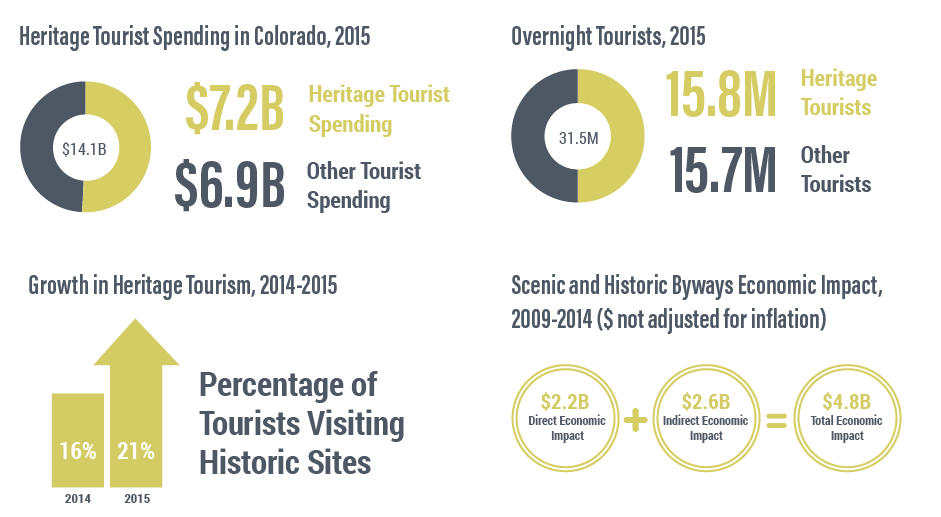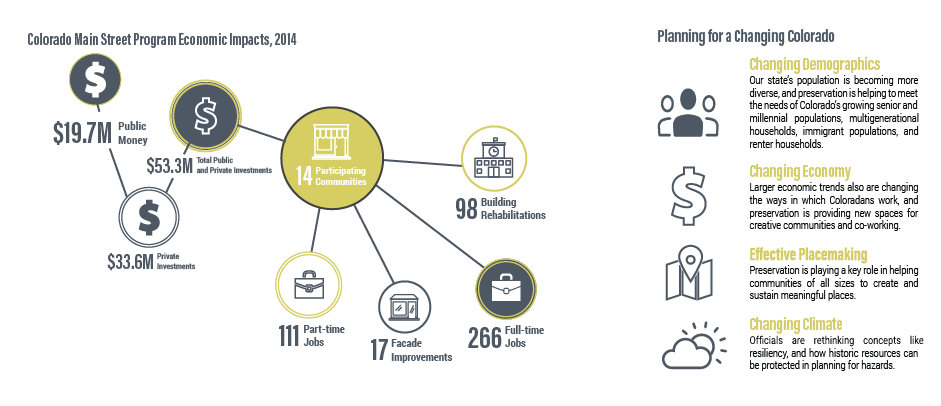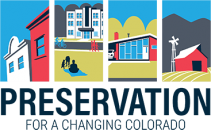 In 2015, total tourist spending in Colorado was $14.1 billion. $7.2 billion was spent through heritage tourism, and $6.9 billion was spent through other types of tourism. In 2015, more than half of overnight tourists visiting Colorado were heritage tourists, totaling 15.8 million. In 2014, 16% of tourists in Colorado visited historic sites. In 2015, the percentage of tourists visiting historic sites rose to 21%. Between 2009 and 2014, the direct economic impact of scenic and historic byways in Colorado was $2.2 billion and the indirect economic impact was $2.6 billion for a total economic impact of $4.8 billion.
In 2015, total tourist spending in Colorado was $14.1 billion. $7.2 billion was spent through heritage tourism, and $6.9 billion was spent through other types of tourism. In 2015, more than half of overnight tourists visiting Colorado were heritage tourists, totaling 15.8 million. In 2014, 16% of tourists in Colorado visited historic sites. In 2015, the percentage of tourists visiting historic sites rose to 21%. Between 2009 and 2014, the direct economic impact of scenic and historic byways in Colorado was $2.2 billion and the indirect economic impact was $2.6 billion for a total economic impact of $4.8 billion.  The Colorado Main Street program leads to demonstrable economic impacts. In 2014, these included: The creation of 266 full-time jobs and 111 part-time jobs, support for 98 new local businesses in the 14 communities that participated in the program during that year, an increase from the previous year, 98 building rehabilitations and 17 façades improvements across all 14 of the participating communities, leveraging nearly $19.7 million of public money to generate an additional $33.6 million in private investments, for a total investment of $53.3 million in rehabilitations or improvements. Changing Demographics: Our state’s population is becoming more diverse, and preservation is helping to meet the needs of Colorado’s growing senior and millennial populations, multigenerational households, immigrant populations, and renter households. Changing Economy: Larger economic trends also are changing the ways in which Coloradans work, and preservation is providing new spaces for creative communities and co-working. Effective Placemaking: Preservation is playing a key role in helping communities of all sizes to create and sustain meaningful places. Changing Climate: Officials are rethinking concepts like resiliency, and how historic resources can be protected in planning for hazards.
The Colorado Main Street program leads to demonstrable economic impacts. In 2014, these included: The creation of 266 full-time jobs and 111 part-time jobs, support for 98 new local businesses in the 14 communities that participated in the program during that year, an increase from the previous year, 98 building rehabilitations and 17 façades improvements across all 14 of the participating communities, leveraging nearly $19.7 million of public money to generate an additional $33.6 million in private investments, for a total investment of $53.3 million in rehabilitations or improvements. Changing Demographics: Our state’s population is becoming more diverse, and preservation is helping to meet the needs of Colorado’s growing senior and millennial populations, multigenerational households, immigrant populations, and renter households. Changing Economy: Larger economic trends also are changing the ways in which Coloradans work, and preservation is providing new spaces for creative communities and co-working. Effective Placemaking: Preservation is playing a key role in helping communities of all sizes to create and sustain meaningful places. Changing Climate: Officials are rethinking concepts like resiliency, and how historic resources can be protected in planning for hazards. 
The Benefits of Historic Preservation
Great preservation work is happening every day all across Colorado, in communities from small to large, from east to west, and from old to new. Federal, state, and local preservation programs provide a range of bene ts to residents of the state, including increased spending in local economies due to rehabilitation grants and tax credits, assisting in the revitalization of communities’ downtowns through initiatives such as the Main Street program, and supporting the state’s growing heritage tourism industry, promoting our state’s historic resources to visitors and residents alike. Historic preservation also plays an important role in helping local communities adapt to a number of trends that look set to bring signi cant changes to Colorado, such as an aging population, increasing millennial workforce, changing workspaces and local economies, and a changing climate. In all, historic preservation has had tremendous impacts on the state since the passage of the National Historic Preservation Act 50 years ago, and is poised to continue to play an important role in Colorado over the next 50 years.
